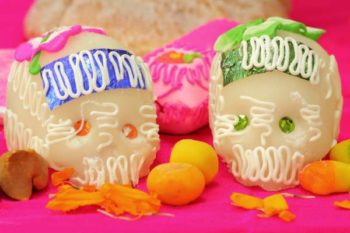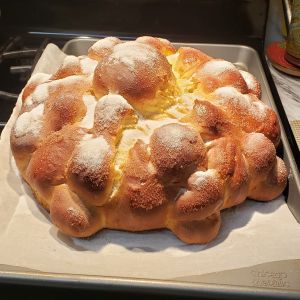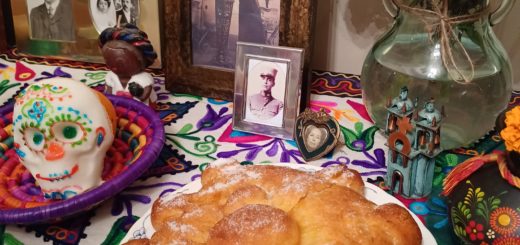Day of the Dead – Why Sugar Skulls 2023
by holidayconnections · Published · Updated
In Europe…
Before Christianity, every culture in the world had some kind of celebration to remember their ancestors, usually combined with harvest and the change of seasons. The Celts as well as the Aztecs included. By the way neither the Celts nor the Aztecs or any other Meso-American culture knew or used sugar before the 1500s, and their offerings were made from their harvest, including honey, fruits, nuts, flowers.
It was until Pope Gregory III (died in 741) who chose November 1, for the dedication day of All Saints Chapel in Rome. The day before, October 31st , was then the feast’s evening vigil, and came to be called “All Hallows Even” in early English and then it was shortened to “Hallows E’en” and later to “Halloween.”
In the Christian kingdoms of León, Aragón y Castilla people made confections to look like the martyrs, bones, fingers, and skulls. In Italy, they looked like fingers and were called “Ossi dei Morti“, [Bones of the Dead] which later became Bones of the Saints. People would have these confections blessed in church and then placed on the “Saints’ Table” at home, where they shared them with family and friends. Recipe
In Mexico,
“The Day of the Dead” might sound harsh and scary, but it is quite the opposite. The word “Dead” means ancestors, grandparents, children that we loved and are no longer with us. The celebraton is a loving expression of love for them, our ancestors. People go to the trouble of setting up the “Ancestors’ Table” with flowers, foods that remind them of their loved ones who are already gone, because, it makes them feel connected with them as if they could enjoy all of that too.
 It was the Spaniards who brought to Mexico wheat flour, butter, eggs, milk, orange trees, almonds, sugar, and anís. And, it was the missionaries and nuns who established the sweets [sugar skulls] and biscocho [pan de muerto] to celebrate All Saints’ Day, and All Souls’ Day, in place of the indigenous pagan celebration dedicated to their ancestors into a more “palatable” Christian one.
It was the Spaniards who brought to Mexico wheat flour, butter, eggs, milk, orange trees, almonds, sugar, and anís. And, it was the missionaries and nuns who established the sweets [sugar skulls] and biscocho [pan de muerto] to celebrate All Saints’ Day, and All Souls’ Day, in place of the indigenous pagan celebration dedicated to their ancestors into a more “palatable” Christian one.
In Palermo at Easter time when little sugar lambs and angels were made to adorn the side altars in the Catholic Church. “Sugar Skulls” are given as a “greeting card” to friends and family, as a way of telling them we thought of them. Here is the recipe for the sugar skulls and here is a great mold I found that you might like!
 In the same manner The “Pan de Muerto” [Bread of the Dead” is placed at the table to remind us to give thanks before we eat. Recipe
In the same manner The “Pan de Muerto” [Bread of the Dead” is placed at the table to remind us to give thanks before we eat. Recipe
I just want to say that it is very sad, and distressing the way the entertainment industry sometimes portrays this celebration. This celebration is not about loving death, this celebration highlights the importance of family, and respect for their ancestors in the Mexican culture. Mexican people do not love death, they love their dear love ones who are dead. There is a difference.
A Skeleton, a skull, their meaning in Literature.
 La Catrina, which is a well-known icon of the “Day of the Dead”, actually became part of the holiday purely by accident. It has no roots in the pre-Hispanic world at all. Catrina is slang for a rich, petulant woman, and dresses in the European style of the Porfirio Diaz era.
La Catrina, which is a well-known icon of the “Day of the Dead”, actually became part of the holiday purely by accident. It has no roots in the pre-Hispanic world at all. Catrina is slang for a rich, petulant woman, and dresses in the European style of the Porfirio Diaz era.
It was during this polarizing reign of dictator Porfirio Díaz that The Catrina was born. In 1913, Mexican artist and illustrator José Guadalupe Posada created the very first version of La Catrina. He was a relief lithographer and printer, who used to write satiric caricatures making fun of politicians and people of the farándula [show biz]
His satirical illustrations and cartoons featured in the magazine, El Jicote played a crucial role for the government during the presidency of Francisco I Madero and during the campaign of Emiliano Zapata. Posada was the creator, but in 1947, Diego Rivera included La Catrina as part of his mural ” Sueño de una Tarde Dominical en la Alameda Central, which is displayed in the Diego Rivera museum.
Questions about Dia de los Muertos and Sugar Skulls.
Q: Are sugar skulls related to Aztec rituals?
A: No, they are not. This blog post clarifies the timing, historically, of how the tradition of gifting sugar skulls came about. See above for more info.
Q: Are sugar skulls supposed to look creepy?
A: No, they are meant to be celebratory gifts of remembrance. That is why, the tradition includes brightly colored flowers and design. The names on the Sugar Skulls refer to either someone we love or someone we are remembering.
Q: Is Dia de los Muertos celebrated in Spain?
A: Not exactly. Dia de los Muertos is a very specific Mexican celebration. However, many Catholic countries like Spain and Italy, do have their own “All Souls Day” celebrations and traditions. See above for more details.



